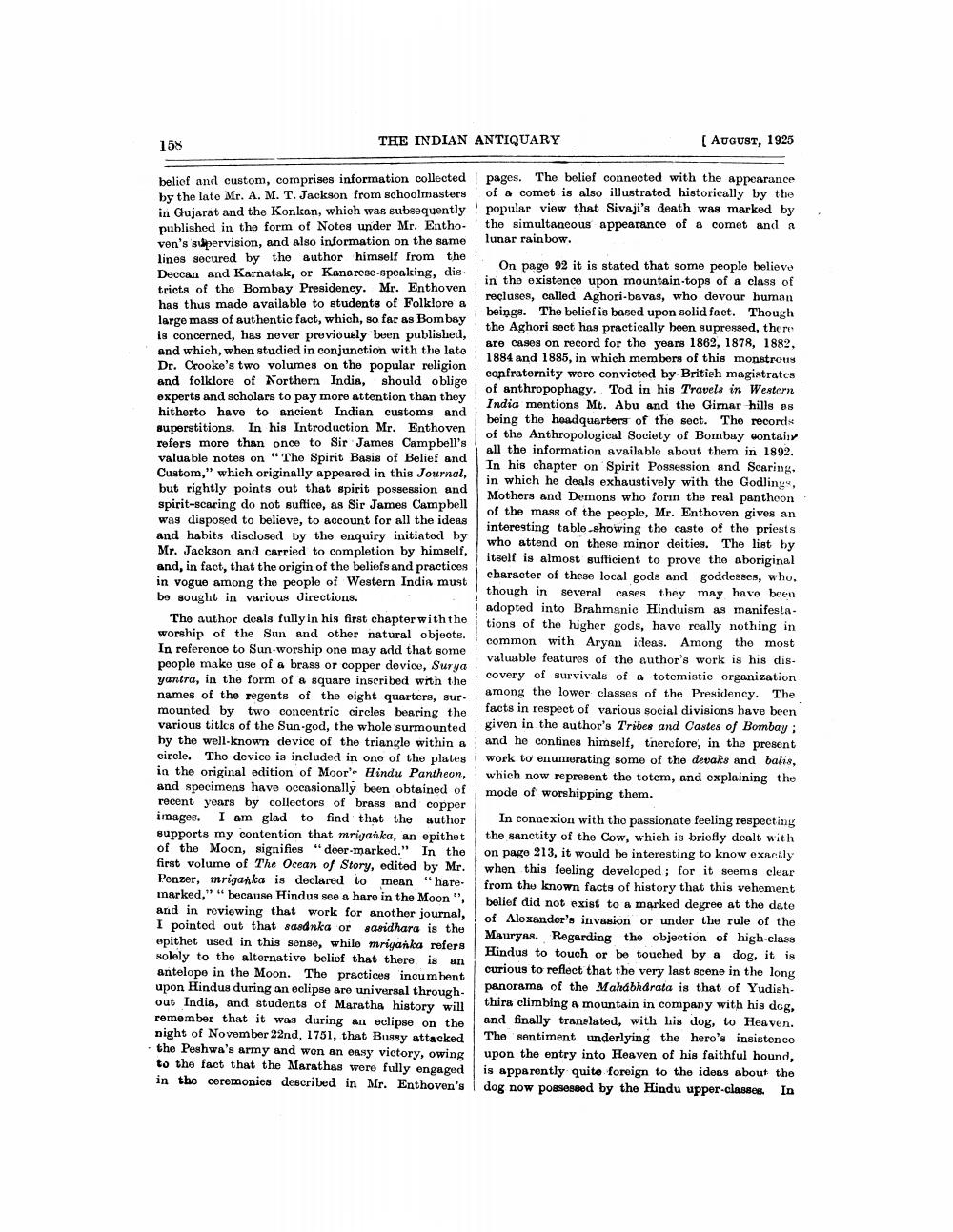________________
( AUGUST, 1925
THE INDIAN ANTIQUARY
158
belief and custom, comprises information collected pages. The belief connected with the appearance by the late Mr. A. M. T. Jackson from schoolmasters of a comet is also illustrated historically by the in Gujarat and the Konkan, which was subsequently popular view that Sivaji's death was marked by published in the form of Notes under Mr. Entho- the simultaneous appearance of a comet and a ven's supervision, and also information on the same lunar rainbow. lines secured by the author himself from the
On page 92 it is stated that some people believe Deccan and Karnatak, or Kanarese-speaking, dis
in the existence upon mountain-tops of a class of tricts of the Bombay Presidency. Mr. Enthoven
recluses, called Aghori-bavas, who devour human has thus made available to students of Folklore a
beings. The belief is based upon solid fact. Though large mass of authentic fact, which, so far as Bombay
the Aghori sect has practically been supressed, there is concerned, has never previously been published,
are cases on record for tho years 1862, 1878, 1882, and which, when studied in conjunction with the lato
1884 and 1885, in which members of this monstrous Dr. Crooke's two volumes on the popular religion
confraternity were convicted by British magistratie and folklore of Northern India, should oblige
of anthropophagy. Tod in his Travels in Western experts and scholars to pay more attention than they
India mentions Mt. Abu and the Gimar hills as hitherto have to ancient Indian customs and
being the headquarters of the sect. The records superstitions. In his Introduction Mr. Enthoven
of the Anthropological Society of Bombay contains refers more than once to Sir James Campbell's
i all the information available about them in 1892. valuable notes on "The Spirit Basis of Belief and
In his chapter on Spirit Possession and Scaring, Custom," which originally appeared in this Journal,
in which he deals exhaustively with the Godlinge, but rightly points out that spirit possession and
Mothers and Demons who form the real pantheon spirit-scaring do not suftice, as Sir James Campbell
of the mass of the people, Mr. Enthoven gives an was disposed to believe, to account for all the ideas
interesting table showing the caste of the priests and habits disclosed by the enquiry initiated by
who attend on these minor deities. The list by Mr. Jackson and carried to completion by himself,
itself is almost sufficient to prove the aboriginal and, in fact, that the origin of the beliefs and practices
character of these local gods and goddesses, who. in vogue among the people of Western India must
though in several cases they may have been bo sought in various directions.
adopted into Brahmanic Hinduism as manifestaThe author deals fully in his first chapter with the
tions of the higher gods, have really nothing in worship of the Sun and other natural objects.
common with Aryan ideas. Among the most In reference to Sun-worship one may add that some
valuable features of the author's work is his dispoople make use of a brass or copper device, Surya yantra, in the form of a square inscribed with the
covery of survivals of a totemistic organization names of the regents of the eight quarters, sur
among the lower classes of the Presidency. The mounted by two concentric circles bearing the
facts in respect of various social divisions have been various titics of the Sun.god, the whole surmounted given in the author's Trior and wastes o bombay hy the well-known device of the triangle within a and he confines himself, therefore, in the present circle. The device is included in one of the plates I work to enumerating some of the devaks and balis, in the original edition of Moor' Hindu Pantheon, which now represent the totem, and explaining the and spocimens have occasionally been obtained of mode of worshipping them. recent years by collectors of brass and copper images. I am glad to find that the author In connexion with the passionate feeling respecting supports my contention that mriganka, an epithet the sanctity of the Cow, which is briefly dealt with of the Moon, signifies "deer-marked." In the on page 213, it would be interesting to know exactly first volume of The Ocean of Story, edited by Mr. when this feeling developed; for it seems clear Ponzer, mriganka is declared to mean "hare.
from the known facts of history that this vehement marked," " because Hindus see a hare in the Moon",
belief did not exist to a marked degree at the date and in reviewing that work for another journal,
of Alexander's invasion or under the rule of the I pointod out that sasdnka or sasidhara is the
Mauryas. Regarding the objection of high-class epithet used in this sense, whilo mriyanka refers solely to the alternative belief that there
Hindus to touch or be touched by a dog, it is
is an antelope in the Moon. The practices incumbent
curious to reflect that the very last scene in the long upon Hindus during an eclipse are universal through
panorama of the Mahabharata is that of Yudishout India, and students of Maratha history will
thira climbing a mountain in company with his dog. remember that it was during an eclipse on the
and finally translated, with his dog, to Heaven. night of November 22nd, 1751, that Bussy attacked
The sentiment underlying the hero's insistence . the Peshwa's army and won an easy victory, owing upon the entry into Heaven of his faithful hound,
to the fact that the Marathas were fully engaged is apparently quite foreign to the ideas about the in the ceremonies described in Mr. Enthoven's I dog now possessed by the Hindu upper-classes. In




